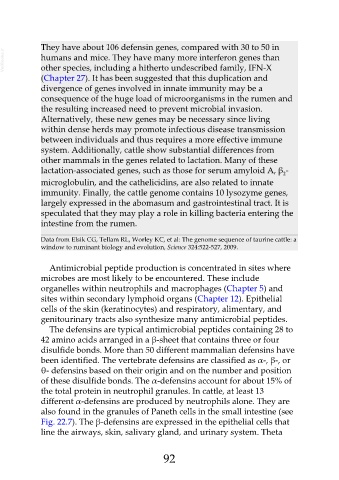Page 92 - Veterinary Immunology, 10th Edition
P. 92
They have about 106 defensin genes, compared with 30 to 50 in
VetBooks.ir humans and mice. They have many more interferon genes than
other species, including a hitherto undescribed family, IFN-X
(Chapter 27). It has been suggested that this duplication and
divergence of genes involved in innate immunity may be a
consequence of the huge load of microorganisms in the rumen and
the resulting increased need to prevent microbial invasion.
Alternatively, these new genes may be necessary since living
within dense herds may promote infectious disease transmission
between individuals and thus requires a more effective immune
system. Additionally, cattle show substantial differences from
other mammals in the genes related to lactation. Many of these
lactation-associated genes, such as those for serum amyloid A, β -
2
microglobulin, and the cathelicidins, are also related to innate
immunity. Finally, the cattle genome contains 10 lysozyme genes,
largely expressed in the abomasum and gastrointestinal tract. It is
speculated that they may play a role in killing bacteria entering the
intestine from the rumen.
Data from Elsik CG, Tellam RL, Worley KC, et al: The genome sequence of taurine cattle: a
window to ruminant biology and evolution, Science 324:522-527, 2009.
Antimicrobial peptide production is concentrated in sites where
microbes are most likely to be encountered. These include
organelles within neutrophils and macrophages (Chapter 5) and
sites within secondary lymphoid organs (Chapter 12). Epithelial
cells of the skin (keratinocytes) and respiratory, alimentary, and
genitourinary tracts also synthesize many antimicrobial peptides.
The defensins are typical antimicrobial peptides containing 28 to
42 amino acids arranged in a β-sheet that contains three or four
disulfide bonds. More than 50 different mammalian defensins have
been identified. The vertebrate defensins are classified as α-, β-, or
θ- defensins based on their origin and on the number and position
of these disulfide bonds. The α-defensins account for about 15% of
the total protein in neutrophil granules. In cattle, at least 13
different α-defensins are produced by neutrophils alone. They are
also found in the granules of Paneth cells in the small intestine (see
Fig. 22.7). The β-defensins are expressed in the epithelial cells that
line the airways, skin, salivary gland, and urinary system. Theta
92

